(Source: Wikipedia)
Borobudur, or Barabudur, is a 9th-century Mahayana Buddhist temple in Magelang, Central Java, Indonesia. The monument consists of nine stacked platforms, six square and three circular, topped by a central dome. The temple is decorated with 2,672 relief panels and 504 Buddha statues. The central dome is surrounded by 72 Buddha statues, each seated inside a perforated stupa.[1] It is the world's largest Buddhist temple,[2][3] as well as one of the greatest Buddhist monuments in the world.[4]
Built in the 9th century during the reign of the Sailendra Dynasty, the temple was designed in Javanese Buddhist architecture, which blends the Indonesian indigenous cult of ancestor worship and the Buddhist concept of attainingNirvana.[4] The temple also demonstrates the influences of Gupta art that reflects India's influence on the region, yet there are enough indigenous scenes and elements incorporated to make Borobudur uniquely Indonesian.[5][6] The monument is both a shrine to the Lord Buddha and a place for Buddhist pilgrimage. The journey for pilgrims begins at the base of the monument and follows a path around the monument and ascends to the top through three levels symbolic of Buddhist cosmology: Kāmadhātu (the world of desire), Rupadhatu (the world of forms) and Arupadhatu(the world of formlessness). The monument guides pilgrims through an extensive system of stairways and corridors with 1,460 narrative relief panels on the walls and the balustrades. Borobudur has the largest and most complete ensemble of Buddhist reliefs in the world.[4]
Evidence suggests Borobudur was constructed in the 9th century and abandoned following the 14th-century decline ofHindu kingdoms in Java and the Javanese conversion to Islam.[7] Worldwide knowledge of its existence was sparked in 1814 by Sir Thomas Stamford Raffles, then the British ruler of Java, who was advised of its location by native Indonesians. Borobudur has since been preserved through several restorations. The largest restoration project was undertaken between 1975 and 1982 by the Indonesian government and UNESCO, following which the monument was listed as a UNESCO World Heritage Site.[4]
Borobudur is still used for pilgrimage; once a year, Buddhists in Indonesia celebrate Vesak at the monument, and Borobudur is Indonesia's single most visited tourist attraction.
In Indonesian, ancient temples are referred to as candi; thus locals refer to "Borobudur Temple" as Candi Borobudur. The term candi also loosely describes ancient structures, for example gates and baths. The origins of the nameBorobudur, however, are unclear,[11] although the original names of most ancient Indonesian temples are no longer known.[11] The name Borobudur was first written in Sir Thomas Raffles's book on Javan history.[12] Raffles wrote about a monument called Borobudur, but there are no older documents suggesting the same name.[11]The only old Javanese manuscript that hints the monument called Budur as a holy Buddhist sanctuary is Nagarakretagama, written by Mpu Prapanca, a Buddhist scholar of Majapahit court, in 1365.[13]
Most candi are named after a nearby village. If it followed Javanese languageconventions and was named after the nearby village of Bore, the monument should have been named "BudurBoro". Raffles thought that Budur might correspond to the modern Javanese word Buda ("ancient")—i.e., "ancient Boro". He also suggested that the name might derive from boro, meaning "great" or "honourable" and Budur for Buddha.[11] However, another archaeologist suggests the second component of the name (Budur) comes from Javanese term bhudhara ("mountain").[14]
Another possible etymology suggests that Borobudur is a corrupted simplified local Javanese pronunciation of Biara Beduhur written in Sanskrit as Vihara Buddha Uhr. The term Buddha-Uhr could mean "the city of Buddhas", while another possible term Beduhur is probably an Old Javanese term, still survived today in Balinese vocabulary, which means "a high place", constructed from the stem word dhuhur or luhur (high). This suggests that Borobudur means vihara of Buddha located on a high place or on a hill.[15]
The construction and inauguration of a sacred Buddhist building—possibly a reference to Borobudur—was mentioned in two inscriptions, both discovered in Kedu,Temanggung Regency. The Karangtengah inscription, dated 824, mentioned a sacred building named Jinalaya (the realm of those who have conquered worldly desire and reached enlightenment), inaugurated by Pramodhawardhani, daughter of Samaratungga. The Tri Tepusan inscription, dated 842, is mentioned in thesima, the (tax-free) lands awarded by Çrī Kahulunnan (Pramodhawardhani) to ensure the funding and maintenance of a Kamūlān called Bhūmisambhāra.[16]Kamūlān is from the word mula, which means "the place of origin", a sacred building to honor the ancestors, probably those of the Sailendras. Casparis suggested that Bhūmi Sambhāra Bhudhāra, which in Sanskrit means "the mountain of combined virtues of the ten stages of Boddhisattvahood", was the original name of Borobudur.[17]
History
Construction
There is no written record of who built the Borobudur or of its intended purpose.[21] The construction time has been estimated by comparison between carved reliefs on the temple's hidden foot and the inscriptionscommonly used in royal charters during the 8th and 9th centuries. Borobudur was likely founded around 800 CE.[21] This corresponds to the period between 760 and 830 CE, the peak of the Sailendra dynasty rule ofMataram kingdom in central Java,[22] when it was under the influence of the Srivijayan Empire. The construction has been estimated to have taken 75 years and was completed during the reign of Samaratungga in 825.[23][24]
There is confusion between Hindu and Buddhist rulers in Java around that time. The Sailendras were known as ardent followers of Buddhism, though stone inscriptions found at Sojomerto suggest they may have been Hindus.[23] It was during this time that many Hindu and Buddhist monuments were built on the plains and mountains around the Kedu Plain. The Buddhist monuments, including Borobudur, were erected around the same period as the Hindu Shiva Prambanan temple compound. In 732 CE, the Shivaite King Sanjayacommissioned a Shivalinga sanctuary to be built on the Wukir hill, only 10 km (6.2 mi) east of Borobudur.[25]
Construction of Buddhist temples, including Borobudur, at that time was possible because Sanjaya's immediate successor, Rakai Panangkaran, granted his permission to the Buddhist followers to build such temples.[26] In fact, to show his respect, Panangkaran gave the village of Kalasan to the Buddhist community, as is written in the Kalasan Charter dated 778 CE.[26] This has led some archaeologists to believe that there was never serious conflict concerning religion in Java as it was possible for a Hindu king to patronize the establishment of a Buddhist monument; or for a Buddhist king to act likewise.[27] However, it is likely that there were two rival royal dynasties in Java at the time—the Buddhist Sailendra and the Saivite Sanjaya—in which the latter triumphed over their rival in the 856 battle on the Ratubaka plateau.[28] This confusion also exists regarding the Lara Jonggrang temple at the Prambanan complex, which was believed to have been erected by the victor Rakai Pikatan as the Sanjaya dynasty's reply to Borobudur,[28] but others suggest that there was a climate of peaceful coexistence where Sailendra involvement exists in Lara Jonggrang.[29]
Abandonment
Borobudur lay hidden for centuries under layers of volcanic ash and jungle growth. The facts behind its abandonment remain a mystery. It is not known when active use of the monument and Buddhist pilgrimage to it ceased. Sometime between 928 and 1006, King Mpu Sindok moved the capital of the Medang Kingdom to the region of East Java after a series of volcanic eruptions; it is not certain whether this influenced the abandonment, but several sources mention this as the most likely period of abandonment.[7][20] The monument is mentioned vaguely as late as c. 1365, in Mpu Prapanca'sNagarakretagama, written during the Majapahit era and mentioning "the vihara in Budur".[30] Soekmono (1976) also mentions the popular belief that the temples were disbanded when the population converted to Islam in the 15th century.[7]
The monument was not forgotten completely, though folk stories gradually shifted from its past glory into more superstitiousbeliefs associated with bad luck and misery. Two old Javanese chronicles (babad) from the 18th century mention cases of bad luck associated with the monument. According to the Babad Tanah Jawi (or the History of Java), the monument was a fatal factor for Mas Dana, a rebel who revolted against Pakubuwono I, the king of Mataram in 1709.[7] It was mentioned that the "Redi Borobudur" hill was besieged and the insurgents were defeated and sentenced to death by the king. In the Babad Mataram (or the History of the Mataram Kingdom), the monument was associated with the misfortune of Prince Monconagoro, the crown prince of the Yogyakarta Sultanate in 1757.[31] In spite of a taboo against visiting the monument, "he took what is written as the knight who was captured in a cage (a statue in one of the perforated stupas)". Upon returning to his palace, he fell ill and died one day later.
Rediscovery
Following its capture, Java was under British administration from 1811 to 1816. The appointed governor was Lieutenant Governor-General Thomas Stamford Raffles, who took great interest in the history of Java. He collected Javanese antiques and made notes through contacts with local inhabitants during his tour throughout the island. On an inspection tour to Semarang in 1814, he was informed about a big monument deep in a jungle near the village of Bumisegoro.[31] He was not able to make the discovery himself and sent H.C. Cornelius, a Dutch engineer, to investigate. In two months, Cornelius and his 200 men cut down trees, burned down vegetation and dug away the earth to reveal the monument. Due to the danger of collapse, he could not unearth all galleries. He reported his findings to Raffles, including various drawings. Although the discovery is only mentioned by a few sentences, Raffles has been credited with the monument's recovery, as one who had brought it to the world's attention.[12]
Hartmann, a Dutch administrator of the Kedu region, continued Cornelius's work, and in 1835, the whole complex was finally unearthed. His interest in Borobudur was more personal than official. Hartmann did not write any reports of his activities, in particular, the alleged story that he discovered the large statue of Buddha in the main stupa.[32] In 1842, Hartmann investigated the main dome, although what he discovered is unknown and the main stupa remains empty.
The Dutch East Indies government then commissioned F.C. Wilsen, a Dutch engineering official, who studied the monument and drew hundreds of relief sketches. J.F.G. Brumund was also appointed to make a detailed study of the monument, which was completed in 1859. The government intended to publish an article based on Brumund's study supplemented by Wilsen's drawings, but Brumund refused to cooperate. The government then commissioned another scholar, C. Leemans, who compiled a monograph based on Brumund's and Wilsen's sources. In 1873, the first monograph of the detailed study of Borobudur was published, followed by its French translation a year later.[32] The first photograph of the monument was taken in 1872 by a Dutch-Flemish engraver, Isidore van Kinsbergen.[33]
Appreciation of the site developed slowly, and it served for some time largely as a source of souvenirs and income for "souvenir hunters" and thieves. In 1882, the chief inspector of cultural artifacts recommended that Borobudur be entirely disassembled with the relocation of reliefs into museums due to the unstable condition of the monument.[33] As a result, the government appointed Groenveldt, an archeologist, to undertake a thorough investigation of the site and to assess the actual condition of the complex; his report found that these fears were unjustified and recommended it be left intact.
Borobudur was considered as the source of souvenirs, and parts of its sculptures were looted, some even with colonial-government consent. In 1896 King Chulalongkorn of Siam visited Java and requested and was allowed to take home eight cartloads of sculptures taken from Borobudur. These include thirty pieces taken from a number of relief panels, five buddha images, two lions, one gargoyle, several kala motifs from the stairs and gateways, and a guardian statue (dvarapala). Several of these artifacts, most notably the lions, dvarapala, kala, makara and giant waterspouts are now on display in the Java Art room in The National Museum in Bangkok.[34]
Restoration
Borobudur attracted attention in 1885, when Yzerman, the Chairman of the Archaeological Society in Yogyakarta, made a discovery about the hidden foot.[35] Photographs that reveal reliefs on the hidden foot were made in 1890–1891.[36] The discovery led the Dutch East Indies government to take steps to safeguard the monument. In 1900, the government set up a commission consisting of three officials to assess the monument: Brandes, an art historian, Theodoor van Erp, a Dutch armyengineer officer, and Van de Kamer, a construction engineer from the Department of Public Works.
In 1902, the commission submitted a threefold plan of proposal to the government. First, the immediate dangers should be avoided by resetting the corners, removing stones that endangered the adjacent parts, strengthening the first balustrades and restoring several niches, archways, stupas and the main dome. Second, after fencing off the courtyards, proper maintenance should be provided and drainage should be improved by restoring floors and spouts. Third, all loose stones should be removed, the monument cleared up to the first balustrades, disfigured stones removed and the main dome restored. The total cost was estimated at that time around 48,800 Dutch guilders.
The restoration then was carried out between 1907 and 1911, using the principles of anastylosis and led by Theodor van Erp.[37] The first seven months of restoration were occupied with excavating the grounds around the monument to find missing Buddha heads and panel stones. Van Erp dismantled and rebuilt the upper three circular platforms and stupas. Along the way, Van Erp discovered more things he could do to improve the monument; he submitted another proposal, which was approved with the additional cost of 34,600 guilders. At first glance, Borobudur had been restored to its old glory. Van Erp went further by carefully reconstructing the chhatra (three-tiered parasol) pinnacle on top of the main stupa. However, he later dismantled the chhatra, citing that there were not enough original stones used in reconstructing the pinnacle, which means that the original design of Borobudur's pinnacle is actually unknown. The dismantled chhatra now is stored in Karmawibhangga Museum, a few hundred meters north from Borobudur.
Due to the limited budget, the restoration had been primarily focused on cleaning the sculptures, and Van Erp did not solve the drainage problem. Within fifteen years, the gallery walls were sagging, and the reliefs showed signs of new cracks and deterioration.[37] Van Erp used concrete from which alkali salts and calcium hydroxide leached and were transported into the rest of the construction. This caused some problems, so that a further thorough renovation was urgently needed.
Small restorations have been performed since then, but not sufficient for complete protection. During World War II and Indonesian National Revolution in 1945 to 1949, Borobudur restoration efforts were halted. The monument suffered further from the weather and drainage problems, which caused the earth core inside the temple to expand, pushing the stone structure and tilting the walls. By 1950s some parts of Borobudur were facing imminent danger of collapsing. In 1965, Indonesia asked the UNESCO for advice on ways to counteract the problem of weathering at Borobudur and other monuments. In 1968 Professor Soekmono, then head of the Archeological Service of Indonesia, launched his "Save Borobudur" campaign, in an effort to organize a massive restoration project.[38]
In the late 1960s, the Indonesian government had requested from the international community a major renovation to protect the monument. In 1973, a master plan to restore Borobudur was created.[39] The Indonesian government and UNESCO then undertook the complete overhaul of the monument in a big restoration project between 1975 and 1982.[37] In 1975, the actual work began. Over one million stones were dismantled and removed during the restoration, and set aside like pieces of a massive jig-saw puzzle to be individually identified, catalogued, cleaned and treated for preservation. Borobudur became a testing ground for new conservation techniques, including new procedures to battle the microorganisms attacking the stone.[38]The foundation was stabilized, and all 1,460 panels were cleaned. The restoration involved the dismantling of the five square platforms and the improvement of drainage by embedding water channels into the monument. Both impermeable and filter layers were added. This colossal project involved around 600 people to restore the monument and cost a total of US$6,901,243.[40]
After the renovation was finished, UNESCO listed Borobudur as a World Heritage Site in 1991.[4] It is listed under Cultural criteria (i) "to represent a masterpiece of human creative genius", (ii) "to exhibit an important interchange of human values, over a span of time or within a cultural area of the world, on developments in architecture or technology, monumental arts, town-planning or landscape design", and (vi) "to be directly or tangibly associated with events or living traditions, with ideas, or with beliefs, with artistic and literary works of outstanding universal significance".[4]
Contemporary events
Religious ceremony
Following the major 1973 renovation funded by UNESCO,[39] Borobudur is once again used as a place of worship and pilgrimage. Once a year, during the full moon in May or June, Buddhists in Indonesia observe Vesak (Indonesian: Waisak) day commemorating the birth, death, and the time when Siddhārtha Gautama attained the highest wisdom to become the Buddha Shakyamuni. Vesak is an official national holiday in Indonesia,[41] and the ceremony is centered at the three Buddhist temples by walking from Mendut to Pawon and ending at Borobudur.[42]
Tourism
The monument is the single most visited tourist attraction in Indonesia. In 1974, 260,000 tourists, of whom 36,000 were foreigners, visited the monument.[9] The figure climbed to 2.5 million visitors annually (80% were domestic tourists) in the mid-1990s, before the country's economic crisis.[10] Tourism development, however, has been criticized for not including the local community, giving rise to occasional conflicts.[9] In 2003, residents and small businesses around Borobudur organized several meetings and poetry protests, objecting to a provincial government plan to build a three-story mall complex, dubbed the "Java World".[43]
International tourism awards were given to Borobudur archaeological park, such as PATA Grand Pacific Award 2004, PATA Gold Award Winner 2011, and PATA Gold Award Winner 2012. In June 2012, Borobudur was recorded in the Guinness Book of World Records as the world's largest Buddhist archaeological site.[44]
Conservation
UNESCO identified three specific areas of concern under the present state of conservation: (i) vandalism by visitors; (ii) soil erosion in the south-eastern part of the site; and (iii) analysis and restoration of missing elements.[45] The soft soil, the numerous earthquakes and heavy rains lead to the destabilization of the structure. Earthquakes are by far the most important contributing factors, since not only do stones fall down and arches crumble, but the earth itself can move in waves, further destroying the structure.[45] The increasing popularity of the stupa brings in many visitors, most of whom are from Indonesia. Despite warning signs on all levels not to touch anything, the regular transmission of warnings over loudspeakers and the presence of guards, vandalism on reliefs and statues is a common occurrence and problem, leading to further deterioration. As of 2009, there is no system in place to limit the number of visitors allowed per day or to introduce mandatory guided tours only.[45]
In August 2014, the Conservation Authority of Borobudur reported some severe abrasion of the stone stairs caused by the scraping of visitors' footwear. The conservation authority planned to install wooden stairs to cover and protect the original stone stairs, just like those installed in Angkor Wat.[46]
Rehabilitation
Borobudur was heavily affected by the eruption of Mount Merapi in October and November 2010. Volcanic ash from Merapi fell on the temple complex, which is approximately 28 kilometres (17 mi) west-southwest of the crater. A layer of ash up to 2.5 centimetres (1 in)[47] thick fell on the temple statues during the eruption of 3–5 November, also killing nearby vegetation, with experts fearing that the acidic ash might damage the historic site. The temple complex was closed from 5 to 9 November to clean up the ashfall.[48][49]
UNESCO donated US$3 million as a part of the costs towards the rehabilitation of Borobudur after Mount Merapi's 2010 eruption.[50] More than 55,000 stone blocks comprising the temple's structure were dismantled to restore the drainage system, which had been clogged by slurry after the rain. The restoration was finished in November.[51]
In January 2012, two German stone-conservation experts spent ten days at the site analyzing the temples and making recommendations to ensure their long-term preservation.[52] In June, Germany agreed to contribute $130,000 to UNESCO for the second phase of rehabilitation, in which six experts in stone conservation, microbiology, structural engineering andchemical engineering would spend a week in Borobudur in June, then return for another visit in September or October. These missions would launch the preservation activities recommended in the January report and would include capacity building activities to enhance the preservation capabilities of governmental staff and young conservation experts.[53]
On 14 February 2014, major tourist attractions in Yogyakarta and Central Java, including Borobudur, Prambanan and Ratu Boko, were closed to visitors, after being severely affected by the volcanic ash from the eruption of Kelud volcano in East Java, located around 200 kilometers east from Yogyakarta. Workers covered the iconic stupas and statues of Borobudur temple to protect the structure from volcanic ash. The Kelud volcano erupted on 13 February 2014 with an explosion heard as far away as Yogyakarta.[54]
Architecture
The archeological excavation into Borobudur during reconstruction suggests that adherents of Hinduism or a pre-Indic faith had already begun to erect a large structure on Borobudur's hill before the site was appropriated by Buddhists. The foundations are unlike any Hindu or Buddhist shrine structures, and therefore, the initial structure is considered more indigenous Javanese than Hindu or Buddhist.[63]
Design
Borobudur is built as a single large stupa and, when viewed from above, takes the form of a giant tantric Buddhist mandala, simultaneously representing the Buddhist cosmology and the nature of mind.[64] The original foundation is a square, approximately 118 metres (387 ft) on each side. It has nine platforms, of which the lower six are square and the upper three are circular.[65] The upper platform features seventy-two small stupas surrounding one large central stupa. Each stupa is bell-shaped and pierced by numerous decorative openings. Statues of the Buddha sit inside the pierced enclosures.
The design of Borobudur took the form of a step pyramid. Previously, the prehistoric Austronesian megalithic culture in Indonesia had constructed several earth mounds and stone step pyramid structures called punden berundak as discovered in Pangguyangan, Cisolok and Gunung Padang, West Java. The construction of stone pyramids is based on native beliefs that mountains and high places are the abode of ancestral spirits or hyangs. The punden berundak step pyramid is the basic design in Borobudur, believed to be the continuation of older megalithic tradition incorporated with Mahayana Buddhist ideas and symbolism.[66]
The monument's three divisions symbolize the three "realms" of Buddhist cosmology, namely Kamadhatu (the world of desires), Rupadhatu (the world of forms), and finally Arupadhatu (the formless world). Ordinary sentient beings live out their lives on the lowest level, the realm of desire. Those who have burnt out all desire for continued existence leave the world of desire and live in the world on the level of form alone: they see forms but are not drawn to them. Finally, full Buddhas go beyond even form and experience reality at its purest, most fundamental level, the formless ocean of nirvana.[67] The liberation from the cycle of Saṃsāra where the enlightened soul had no longer attached to worldly form corresponds to the concept of Śūnyatā, the complete voidness or the nonexistence of the self. Kāmadhātu is represented by the base,Rupadhatu by the five square platforms (the body), and Arupadhatu by the three circular platforms and the large topmost stupa. The architectural features between the three stages have metaphorical differences. For instance, square and detailed decorations in the Rupadhatu disappear into plain circular platforms in the Arupadhatu to represent how the world of forms—where men are still attached with forms and names—changes into the world of the formless.[68]
Congregational worship in Borobudur is performed in a walking pilgrimage. Pilgrims are guided by the system of staircases and corridors ascending to the top platform. Each platform represents one stage of enlightenment. The path that guides pilgrims was designed to symbolize Buddhist cosmology.[69]
In 1885, a hidden structure under the base was accidentally discovered.[35] The "hidden footing" contains reliefs, 160 of which are narratives describing the realKāmadhātu. The remaining reliefs are panels with short inscriptions that apparently provide instructions for the sculptors, illustrating the scenes to be carved.[70] The real base is hidden by an encasement base, the purpose of which remains a mystery. It was first thought that the real base had to be covered to prevent a disastrous subsidence of the monument into the hill.[70] There is another theory that the encasement base was added because the original hidden footing was incorrectly designed, according to Vastu Shastra, the Indian ancient book about architecture and town planning.[35] Regardless of why it was commissioned, the encasement base was built with detailed and meticulous design and with aesthetic and religious consideration.
Building structure
Approximately 55,000 cubic metres (72,000 cu yd) of andesite stones were taken from neighbouring stone quarries to build the monument.[71] The stone was cut to size, transported to the site and laid without mortar. Knobs, indentations and dovetails were used to form joints between stones. Reliefswere created in situ after the building had been completed.
The monument is equipped with a good drainage system to cater to the area's high stormwater run-off. To prevent flooding, 100 spouts are installed at each corner, each with a unique carved gargoyle in the shape of a giant or makara.
Borobudur differs markedly from the general design of other structures built for this purpose. Instead of being built on a flat surface, Borobudur is built on a natural hill. However, construction technique is similar to other temples in Java. Without the inner spaces seen in other temples, and with a general design similar to the shape of pyramid, Borobudur was first thought more likely to have served as a stupa, instead of a temple.[71] A stupa is intended as a shrine for the Buddha. Sometimes stupas were built only as devotional symbols of Buddhism. A temple, on the other hand, is used as a house of worship. The meticulous complexity of the monument's design suggests that Borobudur is in fact a temple.
Little is known about Gunadharma, the architect of the complex.[72] His name is recounted from Javanese folk tales rather than from written inscriptions.
The basic unit of measurement used during construction was the tala, defined as the length of a human face from the forehead's hairline to the tip of the chin or the distance from the tip of the thumb to the tip of the middle finger when both fingers are stretched at their maximum distance.[73] The unit is thus relative from one individual to the next, but the monument has exact measurements. A survey conducted in 1977 revealed frequent findings of a ratio of 4:6:9 around the monument. The architect had used the formula to lay out the precise dimensions of the fractal and self-similar geometry in Borobudur's design.[73][74] This ratio is also found in the designs of Pawon and Mendut, nearby Buddhist temples. Archeologists have conjectured that the 4:6:9 ratio and the tala have calendrical, astronomical and cosmological significance, as is the case with the temple of Angkor Wat in Cambodia.[72]
The main structure can be divided into three components: base, body, and top.[72] The base is 123 m × 123 m (404 ft × 404 ft) in size with 4 metres (13 ft) walls.[71] The body is composed of five square platforms, each of diminishing height. The first terrace is set back 7 metres (23 ft) from the edge of the base. Each subsequent terrace is set back 2 metres (6.6 ft), leaving a narrow corridor at each stage. The top consists of three circular platforms, with each stage supporting a row of perforated stupas, arranged in concentric circles. There is one main dome at the center, the top of which is the highest point of the monument, 35 metres (115 ft) above ground level. Stairways at the center of each of the four sides give access to the top, with a number of arched gates overlooked by 32 lion statues. The gates are adorned with Kala's head carved on top of each and Makaras projecting from each side. This Kala-Makara motif is commonly found on the gates of Javanese temples. The main entrance is on the eastern side, the location of the first narrative reliefs. Stairways on the slopes of the hill also link the monument to the low-lying plain.
Reliefs
Borobudur is constructed in such a way that it reveals various levels of terraces, showing intricate architecture that goes from being heavily ornamented with bas-reliefs to being plain in Arupadhatu circular terraces.[75] The first four terrace walls are showcases for bas-relief sculptures. These are exquisite, considered to be the most elegant and graceful in the ancient Buddhist world.[76]
The bas-reliefs in Borobudur depicted many scenes of daily life in 8th-century ancient Java, from the courtly palace life, hermit in the forest, to those of commoners in the village. It also depicted temple, marketplace, various flora and fauna, and also native vernacular architecture. People depicted here are the images of king, queen, princes, noblemen, courtier, soldier, servant, commoners, priest and hermit. The reliefs also depicted mythical spiritual beings in Buddhist beliefs such as asuras, gods, boddhisattvas, kinnaras, gandharvas and apsaras. The images depicted on bas-relief often served as reference for historians to research for certain subjects, such as the study of architecture, weaponry, economy, fashion, and also mode of transportation of 8th-century Maritime Southeast Asia. One of the famous renderings of an 8th-century Southeast Asian double outrigger ship is Borobudur Ship.[77] Today, the actual-size replica of Borobudur Ship that had sailed from Indonesia to Africa in 2004 is displayed in the Samudra Raksa Museum, located a few hundred meters north of Borobudur.[78]
The Borobudur reliefs also pay close attention to Indian aesthetic discipline, such as pose and gesture that contain certain meanings and aesthetic value. The reliefs of noblemen, and noble women, kings, or divine beings such as apsaras, taras and boddhisattvas are usually portrayed intribhanga pose, the three-bend pose on neck, hips, and knee, with one leg resting and one upholding the body weight. This position is considered as the most graceful pose, such as the figure of Surasundari holding a lotus.[79]
During Borobudur excavation, archeologists discovered colour pigments of blue, red, green, black, as well as bits of gold foil, and concluded that the monument that we see today — a dark gray mass of volcanic stone, lacking in colour — was probably once coated with varjalepa white plaster and then painted with bright colors, serving perhaps as a beacon of Buddhist teaching.[80] The same vajralepa plaster can also be found in Sari, Kalasan and Sewu temples. It is likely that the bas-reliefs of Borobudur was originally quite colourful, before centuries of torrential tropical rainfalls peeled-off the colour pigments.
| Narrative Panels Distribution[81] | |||
|---|---|---|---|
| section | location | story | #panels |
| hidden foot | wall | Karmavibhangga | 160 |
| first gallery | main wall | Lalitavistara | 120 |
| Jataka/Avadana | 120 | ||
| balustrade | Jataka/Avadana | 372 | |
| Jataka/Avadana | 128 | ||
| second gallery | balustrade | Jataka/Avadana | 100 |
| main wall | Gandavyuha | 128 | |
| third gallery | main wall | Gandavyuha | 88 |
| balustrade | Gandavyuha | 88 | |
| fourth gallery | main wall | Gandavyuha | 84 |
| balustrade | Gandavyuha | 72 | |
| Total | 1,460 | ||
Borobudur contains approximately 2,670 individual bas reliefs (1,460 narrative and 1,212 decorative panels), which cover the façades and balustrades. The total relief surface is 2,500 square metres (27,000 sq ft), and they are distributed at the hidden foot (Kāmadhātu) and the five square platforms (Rupadhatu).[81]
The narrative panels, which tell the story of Sudhana and Manohara,[82] are grouped into 11 series that encircle the monument with a total length of 3,000 metres (9,800 ft). The hidden foot contains the first series with 160 narrative panels, and the remaining 10 series are distributed throughout walls and balustrades in four galleries starting from the eastern entrance stairway to the left. Narrative panels on the wall read from right to left, while those on the balustrade read from left to right. This conforms with pradaksina, the ritual of circumambulation performed by pilgrims who move in a clockwise direction while keeping the sanctuary to their right.[83]
The hidden foot depicts the workings of karmic law. The walls of the first gallery have two superimposed series of reliefs; each consists of 120 panels. The upper part depicts the biography of the Buddha, while the lower part of the wall and also the balustrades in the first and the second galleries tell the story of the Buddha's former lives.[81] The remaining panels are devoted to Sudhana's further wandering about his search, terminated by his attainment of the Perfect Wisdom.






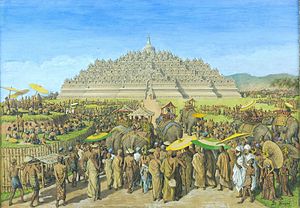





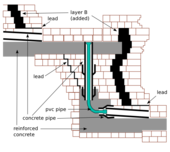
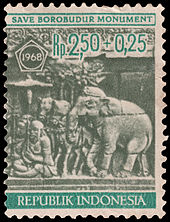


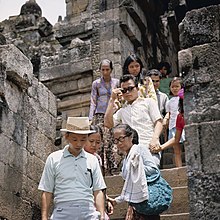

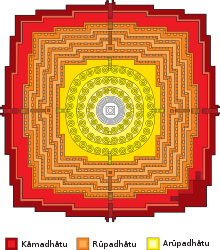


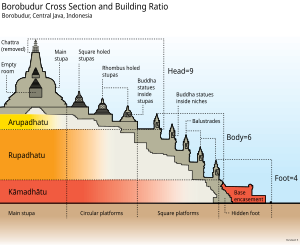




No comments:
Post a Comment